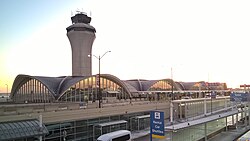St. Louis Lambert International Airport | |||||||||||||||||||||||
|---|---|---|---|---|---|---|---|---|---|---|---|---|---|---|---|---|---|---|---|---|---|---|---|
 | |||||||||||||||||||||||
 | |||||||||||||||||||||||
| Summary | |||||||||||||||||||||||
| Airport type | Public | ||||||||||||||||||||||
| Owner/Operator | City of St. Louis Government | ||||||||||||||||||||||
| Serves | |||||||||||||||||||||||
| Location | Berkeley and Bridgeton, Missouri, U.S. | ||||||||||||||||||||||
| Opened | February 27, 1928 | ||||||||||||||||||||||
| Elevation AMSL | 605 ft / 184 m | ||||||||||||||||||||||
| Coordinates | 38°44′50″N 090°21′41″W / 38.74722°N 90.36139°W | ||||||||||||||||||||||
| Website | www | ||||||||||||||||||||||
| Maps | |||||||||||||||||||||||
 FAA airport diagram | |||||||||||||||||||||||
 | |||||||||||||||||||||||
| Runways | |||||||||||||||||||||||
| |||||||||||||||||||||||
| Statistics (2023) | |||||||||||||||||||||||
| |||||||||||||||||||||||
Source: St. Louis Lambert International Airport[1] | |||||||||||||||||||||||
St. Louis Lambert International Airport (IATA: STL, ICAO: KSTL, FAA LID: STL) is the primary international airport serving metropolitan St. Louis, Missouri, United States. Commonly referred to as Lambert Field or simply Lambert, it is the largest and busiest airport in the state of Missouri. The airport covers 3,793 acres (1,535 ha)[2][3] of land. STL is located 14 miles (23 km) northwest of downtown St. Louis in unincorporated St. Louis County between Berkeley and Bridgeton. The airport provides nonstop service to airports throughout the United States and to the Caribbean, Mexico, Canada, and Europe. In 2019, it served nearly 16 million passengers. In 2023 there were more than 270 daily departures to 80 nonstop domestic and international locations.[4]
Named for Albert Bond Lambert, an Olympic medalist and prominent St. Louis aviator, the airport rose to international prominence in the 20th century thanks to its association with Charles Lindbergh, its groundbreaking air traffic control (ATC), its status as the primary hub of Trans World Airlines (TWA), and its iconic terminal.[5]
St. Louis Lambert International Airport is connected by the MetroLink mass transportation rail system to other parts of the St. Louis metropolitan area, including a future connection to the region's secondary commercial airport, MidAmerica St. Louis Airport about 37 miles (60 km) to the east.[6]
- ^ "CY2023 Passenger & Operation Statistics" (PDF). St. Louis: St. Louis City Airport Commission. February 2, 2024. Archived from the original on August 5, 2020. Retrieved February 9, 2022.
- ^ FAA Airport Form 5010 for STL PDF. Effective October 31, 2024.
- ^ "STL airport data at skyvector.com". skyvector.com. Archived from the original on May 28, 2023. Retrieved May 31, 2023.
- ^ Departure Statistics (Report). St. Louis: St. Louis City Airport Commission. January 29, 2019. Archived from the original on January 30, 2019. Retrieved January 29, 2019.
- ^ Cite error: The named reference
LHwas invoked but never defined (see the help page). - ^ Schlinkmann, Mark. "Illinois to pay for long-sought MetroLink extension to MidAmerica Airport". St. Louis Post-Dispatch. St. Louis: Lee Enterprises. Archived from the original on November 2, 2021. Retrieved November 2, 2021.